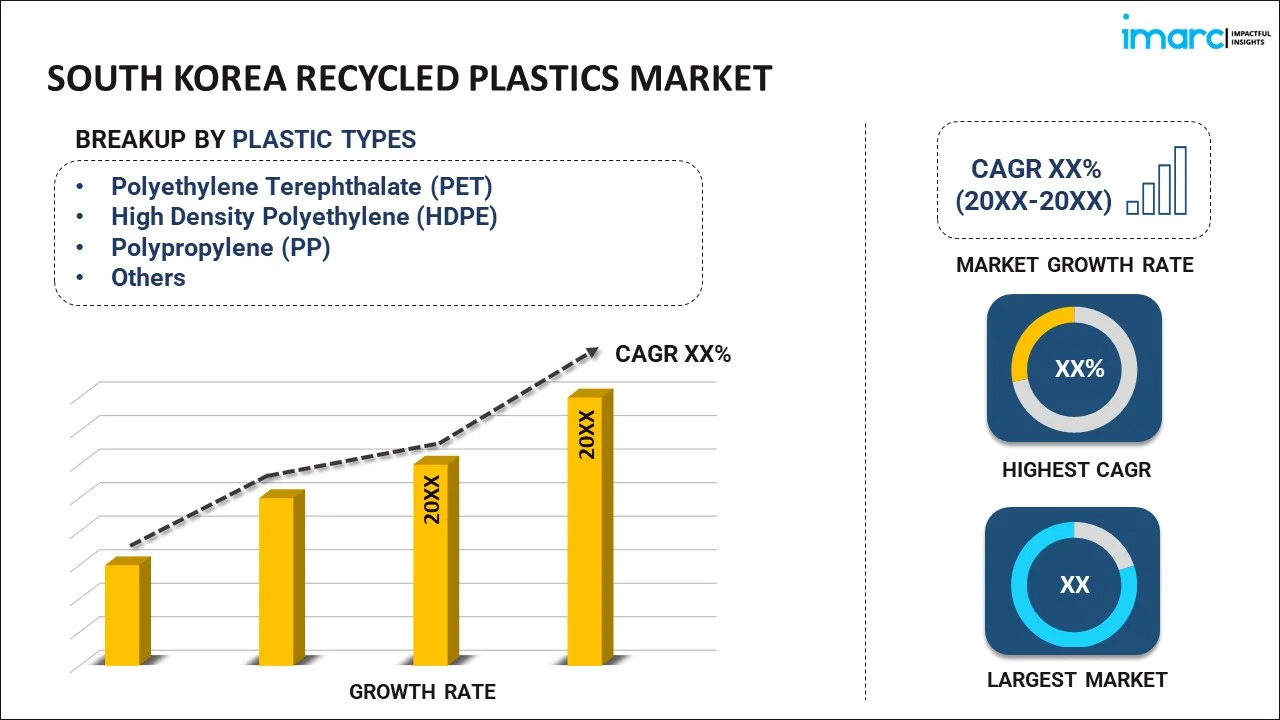
South Korea Recycled Plastics Market Report by Plastic Type (Polyethylene Terephthalate (PET), High Density Polyethylene (HDPE), Polypropylene (PP), Low Density Polyethylene (LDPE), and Others), Raw Material (Plastic Bottles, Plastic Films, Rigid Plastic and Foam, Fibres, and Others), Application (Non-Food Contact Packaging, Food Contact Packaging, Construction, Automotive, and Others), and Region 2025-2033
Market Overview 2025-2033:
The South Korea recycled plastics market size reached 12.9 Million Tons in 2024. Looking forward, IMARC Group expects the market to reach 22.5 Million Tons by 2033, exhibiting a growth rate (CAGR) of 6.05% during 2025-2033.
|
Report Attribute
|
Key Statistics
|
|---|---|
|
Base Year
|
2024
|
|
Forecast Years
|
2025-2033
|
|
Historical Years
|
2019-2024
|
|
Market Size in 2024
|
12.9 Million Tons |
|
Market Forecast in 2033
|
22.5 Million Tons |
| Market Growth Rate (2025-2033) | 6.05% |
Plastic recycling refers to the process of recovering and reprocessing post-industrial plastic into valuable products. Some of the common types of plastics include polyethylene terephthalate (PET), high-density polyethylene (HDPE), polypropylene (PP), and low-density polyethylene (LDPE). The collected waste goes through sorting, washing, shredding, identification and classification, and extruding. Plastic recycling helps to manufacture biodegradable products, reduce landfill dependence, minimize plastic pollution, conserve resources, and prevent greenhouse gas emissions.
South Korea recycled plastics market is primarily being driven by rapid industrialization and shifting focus towards sustainability. Lower labor costs and rising awareness regarding the harmful effects of plastic waste are further contributing to the market growth in the country. Besides this, the market growth is being fueled by the escalating demand for recycled plastic across the food and beverage (F&B), automotive, electronics, and packaging industries. Moreover, the Government of South Korea is establishing plastic recycling plants to process plastic waste into new materials and effectively control waste production. Apart from this, technological innovations, such as the adoption of artificial intelligence (AI) for sorting plastic waste and enhance the quality of recycled plastic products, are positively influencing the market growth in the country.
Key Market Segmentation:
IMARC Group provides an analysis of the key trends in each sub-segment of the South Korea recycled plastics market report, along with forecasts at the country level from 2025-2033. Our report has categorized the market based on plastic type, raw material, and application.
Breakup by Plastic Type:

- Polyethylene Terephthalate (PET)
- High Density Polyethylene (HDPE)
- Polypropylene (PP)
- Low Density Polyethylene (LDPE)
- Others
Breakup by Raw Material:
- Plastic Bottles
- Plastic Films
- Rigid Plastic and Foam
- Fibres
- Others
Breakup by Application:
- Non-Food Contact Packaging
- Food Contact Packaging
- Construction
- Automotive
- Others
Breakup by Region:
- East
- West
- Southwest
- Southeast
Competitive Landscape:
The competitive landscape of the industry has also been examined along with the profiles of the key players.
Report Coverage:
| Report Features | Details |
|---|---|
| Base Year of the Analysis | 2024 |
| Historical Period | 2019-2024 |
| Forecast Period | 2025-2033 |
| Units | Million Tons |
| Segment Coverage | Plastic Type, Raw Material, Application, Region |
| Region Covered | East, West, Southwest, Southeast |
| Customization Scope | 10% Free Customization |
| Post-Sale Analyst Support | 10-12 Weeks |
| Delivery Format | PDF and Excel through Email (We can also provide the editable version of the report in PPT/Word format on special request) |
Key Questions Answered in This Report:
- How has the South Korea recycled plastics market performed so far and how will it perform in the coming years?
- What has been the impact of COVID-19 on the South Korea recycled plastics market?
- What are the key regional markets?
- What is the breakup of the market based on the plastic type?
- What is the breakup of the market based on the raw material?
- What is the breakup of the market based on the application?
- What are the various stages in the value chain of the industry?
- What are the key driving factors and challenges in the industry?
- What is the structure of the South Korea recycled plastics market and who are the key players?
- What is the degree of competition in the industry?
Need more help?
- Speak to our experienced analysts for insights on the current market scenarios.
- Include additional segments and countries to customize the report as per your requirement.
- Gain an unparalleled competitive advantage in your domain by understanding how to utilize the report and positively impacting your operations and revenue.
- For further assistance, please connect with our analysts.
 Inquire Before Buying
Inquire Before Buying
 Speak to an Analyst
Speak to an Analyst
 Request Brochure
Request Brochure
 Request Customization
Request Customization




.webp)




.webp)












